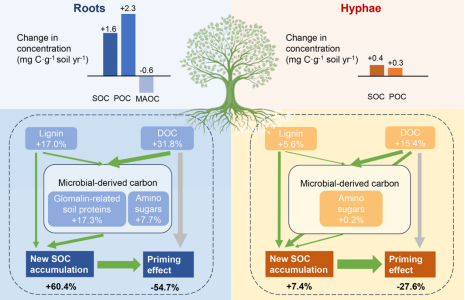
A research team led by the South China Botanical Garden of the Chinese Academy of Sciences has achieved a breakthrough in understanding soil carbon sequestration in tropical forests, revealing for the first time that plant roots are the primary drivers of soil organic carbon (SOC) accumulation—contributing nearly four times more than extraradical mycorrhizal hyphae.
The findings, recently published in Global Change Biology, conducted in collaboration with researchers from the United States, Australia, and Spain. The study offers new insights for managing tropical forest carbon sinks.
To quantify the relative contributions of roots and fungal hyphae to soil carbon inputs, the team designed a two-year in situ field experiment across three representative tropical forest types along a successional gradient: Pinus massoniana forest, pine-broadleaf mixed forest, and monsoon evergreen broadleaf forest. They combined isotope tracing techniques with ingrowth-core bags of varying mesh sizes—an approach that allowed for precise measurement of carbon flow from different sources.
The data showed roots contributed an average of 1.2 mg of carbon per gram of soil annually, nearly four times higher than the 0.32 mg per gram contributed by extraradical hyphae. Beyond driving greater carbon input, roots also played a dual role in boosting sequestration: they enhanced the incorporation of new carbon into soil and suppressed the decomposition of existing organic carbon, resulting in a net gain of soil carbon. Most of this sequestered carbon was stored as particulate organic carbon (POC)—a relatively stable form of soil carbon that can persist for years to decades.
Furthermore, the researchers uncovered distinct carbon input strategies across forest successional stages: Early-successional forests, dominated by arbuscular mycorrhizal (AM) plants, relied on fast-turnover roots to deliver large volumes of carbon to soil. Mid-successional forests, where ectomycorrhizal (ECM) fungi are prevalent, exhibited more stable carbon inputs due to the longer lifespan of fungal hyphae. Late-successional forests developed a functionally complementary mechanism, integrating both root and fungal pathways to optimize carbon sequestration.
This study clarifies the relative roles of roots and hyphae in tropical forest soil carbon sequestration and highlights the central importance of root traits in carbon storage, the researchers noted.

Conceptual diagram showing how roots and extraradical hyphae influence soil organic carbon dynamics and net change. (Image by CHEN Xiaolin et al)

86-10-68597521 (day)
86-10-68597289 (night)

52 Sanlihe Rd., Xicheng District,
Beijing, China (100864)

